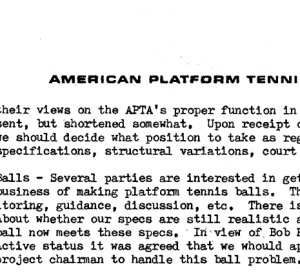APTA looks into ball specifications
Ball quality had been a constant problem, and if anything, it seemed to get worse as time went on.
The APTA concluded that either suppliers were not making balls to its specifications, or the specifications themselves were incorrect.
The APTA invited sixteen top players to Fox Meadow to spend the day playing with balls in an organized testing program. Bob Brown and Amby Hardwick, who was the New Jersey Regional Vice President of the Association, chaired the project committee. Balls manufactured by Barr, Marcraft, Eagle Seamco and Robinson Bros. were tested and balls that met players’ approval were then further tested by the U. S. Testing Company so that they could draw up a set of specifications. Companies who met the specifications were issued approvals.
The APTA encouraged a number of manufacturers in the sporting goods field interested in making balls for platform tennis to develop prototypes and submit them for approval. The results were encouraging. The new balls lasted longer, played more consistently, and the velour-type flocking was a vast improvement and worth the increased cost. Among possible new developments were hollow balls, tested and deemed “interesting” by the test squad. A yellow colored ball, for higher visibility during night play, was also tested. All the manufacturers were told that the requirement for approval beyond the current season was the consistency of playing qualities.
In 1972, the Eagle Seamco (or Rubber) Company had submitted samples of yellow balls to the APTA that met ball specifications. They promoted the yellow coloring as having better visibility, especially at night. The balls were made available along with the traditional orange ball. Over the next two years, sales rapidly outgrew those of the orange ball and, by the end of 1974, orange balls were extinct.
The 1974 Nationals were the last ones to use the orange ball.
Source: The APTA Paddle Newsletter, Vol. 4 No. 4; Off The Wire, Vol. 5 No. 1; and Robert A. Brown, personal communication




